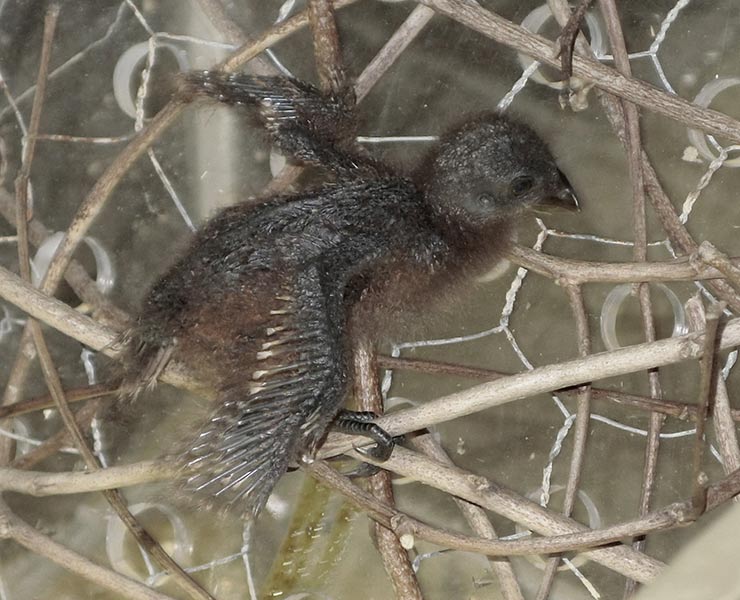How about these unusual birds, eh? Some highlights bolded.
https://en.wikipedia.org/wiki/Hoatzin
The hoatzin, also known as the reptile bird, skunk bird, stinkbird, or Canje pheasant, is a species of tropical bird found in swamps, riparian forests, and mangroves of the Amazon and the Orinoco basins in South America. It is notable for having chicks that have claws on two of their wing digits.
It is the only member of the genus Opisthocomus (Ancient Greek: “long hair behind”, referring to its large crest). This is the only extant genus in the family Opisthocomidae. The taxonomic position of this family has been greatly debated by specialists, and is still far from clear.
The hoatzin is pheasant-sized, with a total length of 65 centimetres (26 in), and a long neck and small head. It has an unfeathered blue face with maroon eyes, and its head is topped by a spiky, rufous crest. The long, sooty-brown tail is a broadly tipped buff. The upper parts are dark, sooty-brown-edged buff on the wing coverts, and streaked buff on the mantle and nape. The under parts are buff, while the crissum (the undertail coverts surrounding the cloaca), primaries, underwing coverts and flanks are rich rufous-chestnut, but this is mainly visible when it opens its wings. The hoatzin is a herbivore, eating leaves and fruit, and has an unusual digestive system with an enlarged crop used for fermentation of vegetable matter, in a manner broadly analogous to the digestive system of mammalian ruminants. The alternative name of “stinkbird” is derived from the bird’s foul odour, which is caused by the fermentation of food in its digestive system.
—-
In 2015, genetic research indicated that the hoatzin is the last surviving member of a bird line that branched off in its own direction 64 million years ago, shortly after the extinction event that killed the non-avian dinosaurs.
—-
The chicks, which are fed on regurgitated fermented food, have another odd feature; they have two claws on each wing. Immediately on hatching, they can use these claws, and their oversized feet, to scramble around the tree branches without falling into the water. When predators such as the great black hawk attack a hoatzin nesting colony, the adults fly noisily about, trying to divert the predator’s attention, while the chicks move away from the nest and hide among the thickets. If discovered, however, they drop into the water and swim under the surface to escape, then later use their clawed wings to climb back to the safety of the nest. This has inevitably led to comparisons to the fossil bird Archaeopteryx, but the characteristic is rather an autapomorphy, possibly caused by an atavism toward the dinosaurian finger claws, whose developmental genetics (“blueprint”) presumably is still in the avian genome. Since Archaeopteryx had three functional claws on each wing, some earlier systematists speculated that the hoatzin was descended from it, because nestling hoatzins have two functional claws on each wing. Modern researchers, however, hypothesize that the young hoatzin’s claws are of more recent origin, and may be a secondary adaptation from its frequent need to leave the nest and climb about in dense vines and trees well before it can fly.

Adult
https://www.youtube.com/watch?v=87_shPJxdns
Hoatzin claws

Young hoatzin with its wing-claws